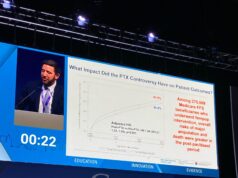Medrad Interventional has announced that five-year data from the THUNDER trial were presented at the 2011 Transcatheter Cardiovascular Therapeutics (TCT) scientific symposium, sponsored by the Cardiovascular Research Foundation, in San Francisco, USA.
The data focused on five-year rates of target lesion revascularisation and compared the Cotavance drug-eluting balloon (DEB) catheter which uses Paccocath technology to standard balloon angioplasty in the popliteal arteries of patients with peripheral arterial disease. Results were presented on 10 November by Thomas Zeller, Herz-Zentrum, Bad Krozingen, Germany, during the TCT-sponsored symposium, “Drug-Coated Balloons: Clinical data and applications.”
The THUNDER study has the only long-term data available. Five-year data show that the drug-eluting balloon with Paccocath technology which has been used in the THUNDER study has a lower rate of re-intervention. After five years, the target lesion revascularisation rate is much lower in the drug-eluting balloon group than in patients who received percutaneous transluminal angioplasty with bail-out stenting.
“The only published positive long-term clinical results to date with drug-eluting balloons have used Medrad’s Paccocath technology, and these new data provide additional information out to five years, the longest time studied among drug-eluting balloons,” said Jack Darby, Medrad’s senior vice president. “We remain committed to further elucidating long-term clinical outcomes with the Cotavance paclitaxel-eluting balloon catheter compared to, or in combination with other interventional therapies through our large clinical studies and registry programme. Collectively, this will include more than 1,700 patients and approximately 200 centres around the world.”
About Cotavance with Paccocath technology
The Cotavance balloon catheter is to be used in percutaneous interventions for the treatment of peripheral arterial disease for balloon dilation of stenotic lesions in the iliac and infrainguinal arteries while applying paclitaxel to the vessel wall to inhibit restenosis. The Paccocath technology is a proprietary drug matrix applied to the balloon of an angioplasty catheter. The matrix consists of paclitaxel, long used in drug-eluting stents to treat cardiovascular disease, and a radiologic contrast agent, Ultravist 370. When the balloon is inflated to dilate the narrowed vessel, paclitaxel is delivered directly to the diseased area.
The Cotavance catheter received CE mark certification in Europe in 2011. The company is moving forward with the investigational device exemption process as one of the steps in gaining FDA approval for the Cotavance product in the United States.












